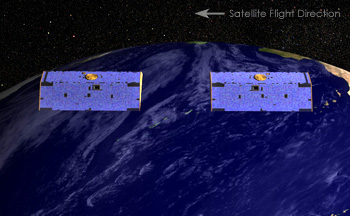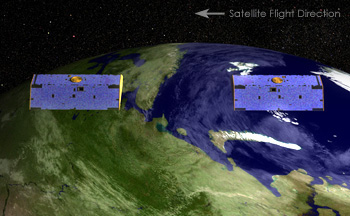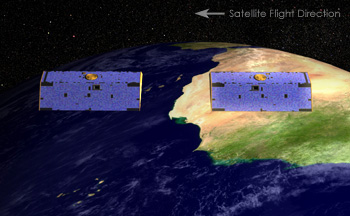
|
GRACE Publications |
|
GRACE will be launched from the Plesetsk Cosmodrome, a former Intercontinental Ballistic Missile (ICBM) site in northern Russia. This site has been one of the most active launch sites in the entire world.EurROCKOT GmbH is providing the launch vehicle. The booster unit is an adaptation of the highly reliable SS-19 ICBM tested in flight over 140 times. A newly developed multi-ignitable and highly maneuverable third stage BREEZE was added. The complete ROCKOT system including BREEZE has been proven in flight three times with a 100% success rate. The payload is assembled on site at Plesetsk and then transported to a launch pad that has been modified to accommodate the ROCKOT launch vehicle. Plesetsk also provides telemetry and tracking services via the existing ground measurement infrastructure.
GRACE is different from most Earth observing satellite missions-Terra and Aqua for example-because it doesn't carry a suite of independent scientific instruments on board. It does not make measurements of the electromagnetic energy reflected back to it from the Earth's surface. Instead, the two GRACE satellites themselves act in unison as the primary instrument. Changes in the distance between the twin satellites are used to make gravitational field measurements. The two identical satellites orbit one behind the other in the same orbital plane at approximate distance of 220 kilometers (137 miles). As the pair circles the Earth, areas of slightly stronger gravity (greater mass concentration) affect the lead satellite first, pulling it away from the trailiing satellite. As the satellites continue along their orbital path, the trailing satellite is pulled toward the lead satellite as it passes over the gravity anomaly. The change in distance would certainly be imperceptible to our eyes, but an extremely precise microwave ranging system on GRACE detects these minuscule changes in the distance between the satellites. A hightly accurate measuring device known as an accelerometer, located at each satellite's center of mass, measures the non-gravitational accelerations (such as those due to atmospheric drag) so that only accelerations cased by gravity are considered. Satellite Global Positioning Syste (GPS) receivers determine the exact position of the satellite over the Earth to within a centimeter or less. Members of the GRACE science team can download all this information from the satellites, and use it to construct monthly maps of the Earth's average gravity field during the planned five-year mission. |




